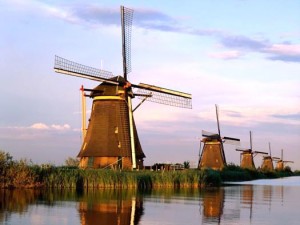- The Netherlands is located in Western Europe, bordered by Belgium to the south, Germany to the east and the North Sea to the north and west. Geographically, the Netherlands is a flat, low-lying country formed by the estuary of four important European rivers: the Rhine, the Meuse, the Ems and the Scheldt.
- Two-thirds of the country is threatened by flooding. Through history, the country has defended itself against threats posed by water, building dikes and dams, canalizing rivers and reclaiming land from the sea. Today, about 9.6 million of its inhabitants (60% of the population) live below sea level, and about 70% of the country’s GDP is generated below sea level thanks to a 3,500 km primary flood defence system composed of dikes and sand dunes.
- Although there are some local water shortages, the presence of large rivers such as the Rhine and its tributaries, as well as the Meuse, ensures that water quantity and water allocation to various sectors are not generally an issue in the Netherlands. Only 9% of the total annual renewable water resources is used. In recent years, however, periods of low river flow have become more frequent and tended to last longer.
- Responsibility for the management of natural water systems in the Netherlands and for protecting residents from flooding is largely allocated to the Waterschappen (regional water authorities or water boards). The 26 current Waterschappen constitute a fourth form of government body in the Netherlands, alongside the central, provincial and municipal governments.
- Floods: The main challenge. Floods have always been a major threat in the Netherlands. They can come from storm surges from the sea, high river discharges after heavy rain or snow-melt upstream, or intense local rainfall.
The section “Did You Know…?” is taken from the 3rd World Water Development Report “Water in a Changing World“.


